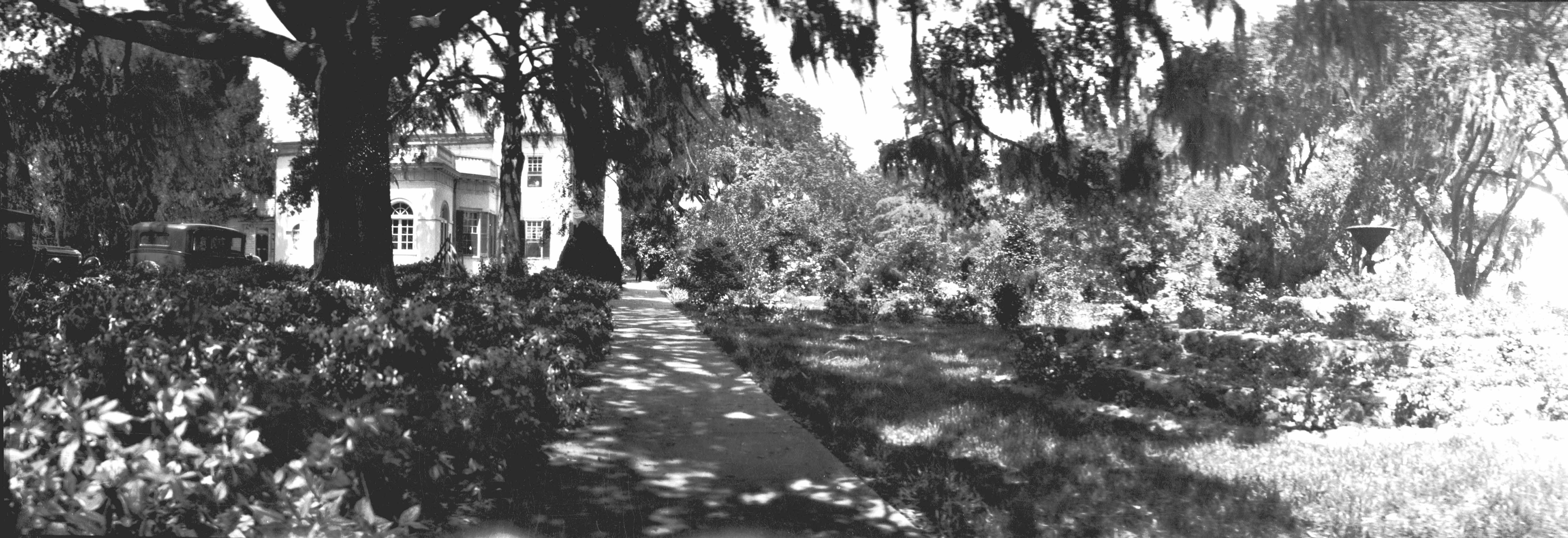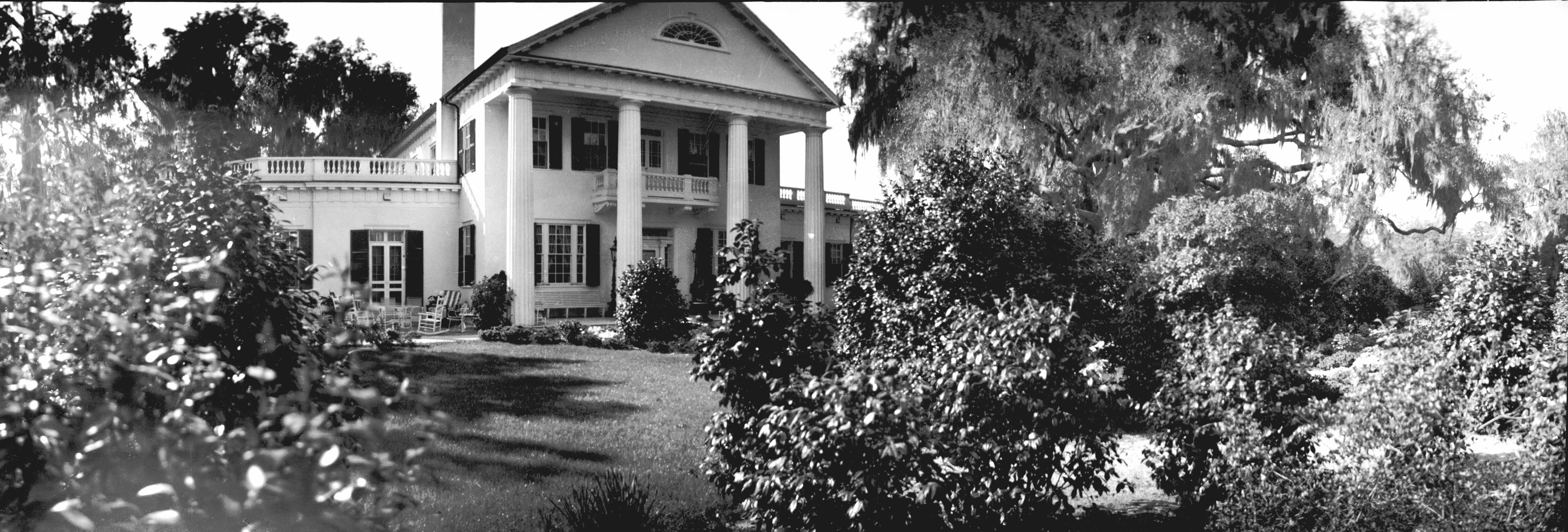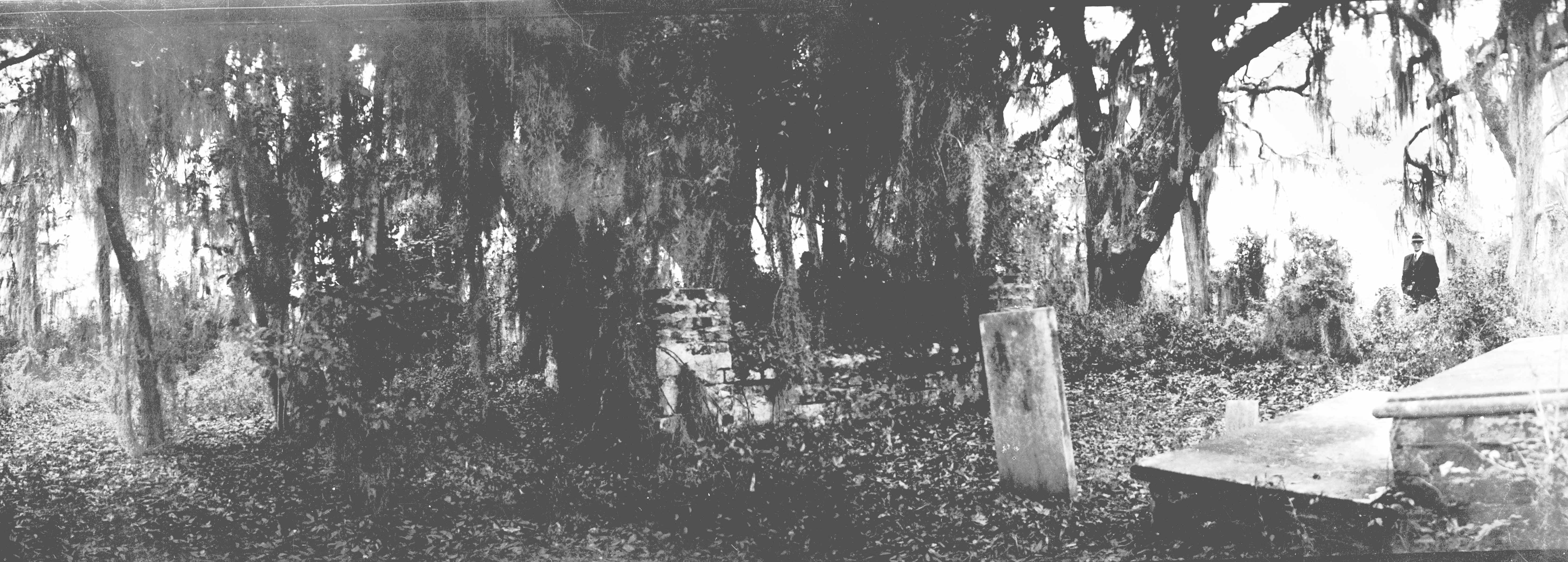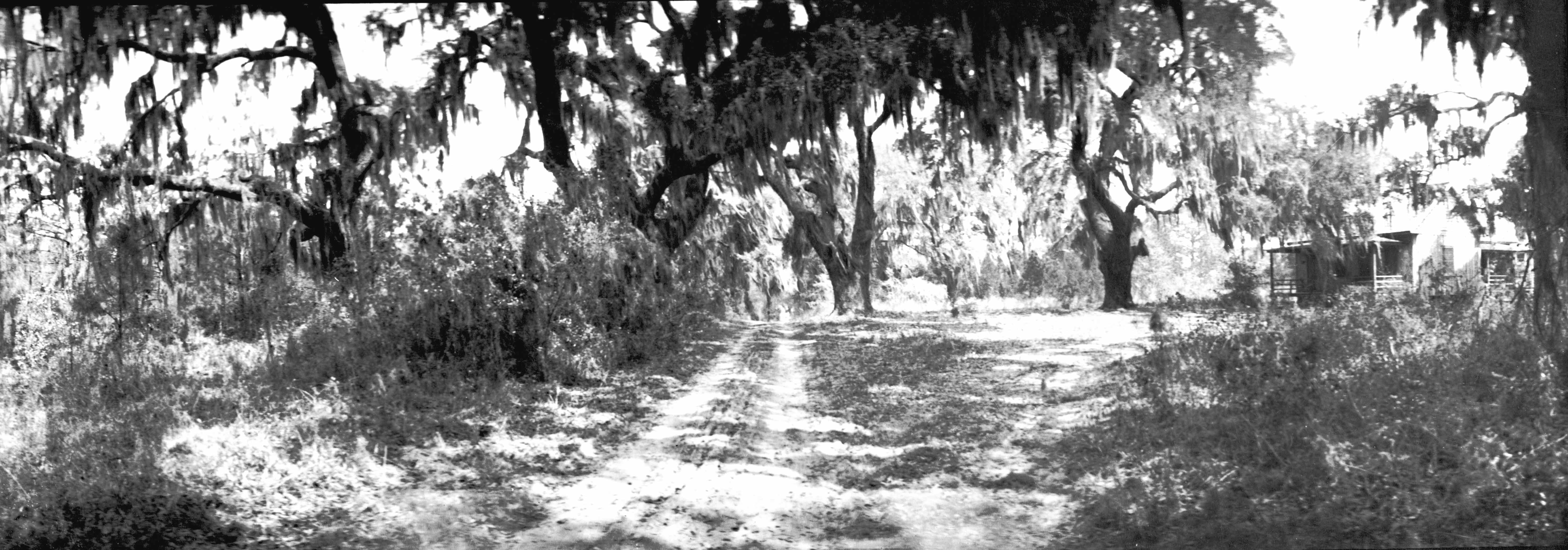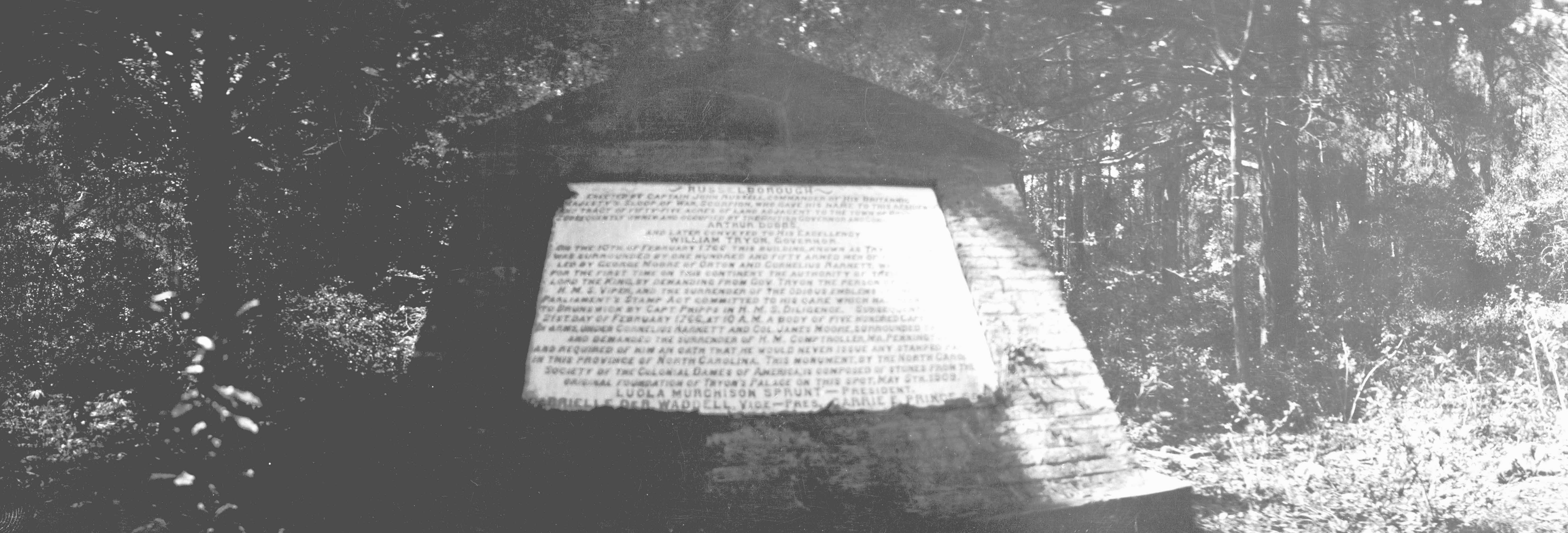by Susan Taylor Block
(Click on photos to magnify. Double-click and scroll to see more.)
This is one of many walkways at Orton Plantation, dappled in sunlight and canopied with oak leaf and moss. Orton Plantation, on the west bank of the Cape Fear River, first was owned, in 1725, by Maurice Moore, son of S. C. Governor James Moore. Maurice named the property for Cole Orton Hall, in Leicester, England, the site of a battle during the English Civil War in which the Royalists were victorious. The Moores were Royalists, and, most likely, participated in the battle.
Maurice Moore, instrumental in the capture of exceptionally arch-pirate, Blackbeard, deeded the property to his brother, “King” Roger Moore (1694-1751), who built the core of the existing house about 1735. Moore family members resided at Orton for two more generations before the property went through a succession of owners including Benjamin Smith, Frederick Jones Hill and Thomas C. Miller, who raised oranges there in a glass house and listened to the sounds of gunboats nearby during the Civil War. Mr. Miller was one of many prominent Cape Fear residents who found Reconstruction economically challenging. Soon, the area’s finest piece of real estate was “on the market.”
“If you wish to make an investment, let me advise you to take hold of Orton. It is now a complete wreck, but nevertheless can be made valuable by the expenditure of a moderate amount,” John C. MacRae wrote to his brother, Donald, February 3, 1866. Donald MacRae eventually invested money in a cotton mill, railroad, warehouse and two banks, but he didn’t tackle Orton. (584)
Ten years later, a buyer finally stepped forward, but he committed suicide soon after receiving the deed. Finally, in 1880, Fayetteville native Colonel Kenneth McKenzie Murchison bought Orton Plantation. Heavily capitalized from business ventures in New York and armed with a personality likened to German chancellor Otto von Bismarck, he determined to make the most of his purchase. “Trees were growing in parts of Orton House,” wrote his grandson, J. Laurence Sprunt. “Twenty-five thousand dollars was required for the repair of the rice fields alone.”
Orton House was restored and the plantation began to function again as a rice and peanut farm. As an elderly man, Col. Murchison cherished his time at Orton. He could have sat in an armchair, mesmerizing many with his tales of the Civil War: guarding Robert E. Lee’s wagon trains; commanding a regiment at Williamsport; and spending twenty months in a Yankee prison on Johnson’s Island, Lake Erie. But he seldom spoke of the war, preferring to roam the beautiful Orton woods alone, except for the company of his beloved hunting dogs.
“The Southerners have been so long emphatically an agricultural people, and have conquered at such expense and with such difficulty a great portion of the land which belongs to them, that they love it with an intensity and devotion equaled in the world only by the attachment of the Swiss peasant to his peaks and the Frenchman to his vineyards,” wrote Edward King, a visitor to Wilmington in 1874. (583)
In 1904, Col. Murchison died and his son-in-law, James Sprunt, purchased Orton from his estate as a gift for his wife, Luola Murchison Sprunt. The transaction brought a new elegance and many illustrious visitors to Orton. Special guests traveled from Wilmington to Orton on James Sprunt’s yacht, the Luola. A mule-drawn flatbed traincar transported them from Orton dock to Orton House where waiting servants toted luggage, served delectable refreshments and bent to brush the crumbs away.
James Sprunt, always fond of sailing vessels and nautical clothes, loved his yacht. In 1909, R. D. Corput, Captain of the Coast Artillery Corps at Fort Caswell, offered to upgrade the engine in the Luola. Sprunt politely declined. “I have no special object to increase the speed of the boat at the risk of the structure. Moreover the boat suits me in every respect. We find it a great addition to the enjoyment of our country life.”
Dr. Sprunt’s brother-in-law, architect Kenneth M. Murchison, designed the wings for the residence, in part to accommodate their many guests. James Sprunt offered a stay at Orton to Woodrow Wilson after he received the presidential nomination in 1912, but Wilson already had planned to vacation in Bermuda. His father, Dr. Joseph Wilson, however, was a frequent visitor to Orton, often accompanied by Samuel Ashe and Sprunt’s brother-in-law, Benjamin Franklin Hall. In 1914, Ashe described Orton as being “redolent with delightful reminiscence.” (778)
In October 1923, the Laird of Lochiel, Donald W. Cameron, and his wife, Lady Hermione Graham, visited Wilmington and were James Sprunt’s guests. He treated them to an oyster roast at the Cazeaux’s, entertained them at his town home and regaled them at Orton. At the Brunswick County plantation, Dr. Sprunt spun local yarns to a group that included Wilmingtonians with tartans hanging in their family trees: Mr. and Mrs. J. Laurence Sprunt, Kate Fairley, Henry McQueen, Sue McQueen, Dr. and Mrs. Edward Jenner Wood and Dr. and Mrs. A. D. P. Gilmour.
When James Sprunt died in 1924, Orton passed to his son, J. Laurence Sprunt. With his wife, Annie Gray. By that time, the original 8000-acre tract had been expanded to 15,000 acres. Churchill Bragaw, an accomplished horticulturist, transformed Orton into a botanical showplace. More improvements followed when Laurence’s son, Kenneth Murchison Sprunt, returned from World War II to manage Orton. The beautified plantation was noted in many magazines, including the August 1941 issue of National Geographic and the cover of a 1946 issue of Holland’s, the Magazine of the South. Today, Orton attracts thousands of visitors annually and has been the backdrop for 35 motion pictures. (777)
This is “King” Roger Moore’s grave in the burial ground at Orton Plantation. Recognizing all genealogy as an accident of birth, Louis T. Moore took it in stride that he descended from Roger Moore, builder of the original house at Orton Plantation. He let others heap platitudes on his ancestors.
In 1914, Bryant Whitlock Ruark wrote in a Trinity College (now Duke University) publication, “Life in the Cape Fear section was distinctive. An aristocratic element was introduced by the coming of the Moore family at the close of the Tuscarora War. Here were to be found large plantations and stately homes. However, the aristocracy of the Cape Fear was not only one of land and of wealth. There was also an aristocracy of brains, and from such families as the Moores, Waddells, Davises and many others came men of rare ability.”
The Moore family’s power and resistance to English rule was strong enough the earn the ire of King George II, who referred to King Roger and his family followers as “those pestiferous Moores.” (580)
In referring to the Moore family tree, Paul Connor wrote Wilmington genealogist Ida Brooks Kellam, in 1963, “Once I find enough papers, I shall have to straighten these relationships out, as a great deal of the influence was due to the intricacies of their intermarriages.” The untangling would not occur in full until the 21st-century when Wilmington historian Ken Davis tackled the project.
Roger Moore was one of nine surviving children born to James Moore and Margaret Berringer. Most of them married into other large powerful families. Roger Moore married the daughter of William Rhett who was also part of a large, well-known family. Rhett was a powerful force in South Carolina politics and the captor of pirate Stede Bonnet. Mrs. Moore was buried near her husband in Orton Cemetery.
The story of the Moore family and Orton came full circle in May 2010, when Louis T. Moore’s grandson, enviromental conservationist Louis Moore Bacon, emerged as new buyer for the plantation Sprunt family members had owned for 126 years. The sale would seem especially sweet to Mr. and Mrs. Louis T. Moore, whose dearest friends were Mr. and Mrs. J. Laurence Sprunt. The couples visited each other frequently in Wilmington, and the Sprunts hosted numerous gatherings of the “Moore Clan” at Orton. (581)
The road from Orton to Brunswick Town was about as likely to contain an alligator as a Model T. Termed by James Sprunt a “paradise of sportsmen,” the plantation has been home to rare specimens. Rice birds, attracted by Orton’s chief crop, were considered a local delicacy. James Stewart, superintendent of Champion Compress, took orders as part of his job description and Orton workmen delivered them to the compress for distributution. In 1900, the going rate was fifty cents per dozen.
A 1932 discovery indicated mammoth game once lumbered across Brunswick County. A “half bushel” of petrified teeth were discovered on the farm of G. E. Earp, in Town Creek. One tooth measured five inches across and 13 inches in length. The teeth were found scattered about on a bed of shale, 3 feet below the surface of the ground.
In February 1933, a trapper at Orton Pond shot several water turkeys, birds that usually remain south of the Florida-Georgia border. The rare fowl, colored similar to domestic turkeys, have elongated necks and bills. District Chief Warden C. H. Hearn mounted one of them, an eighteen-pounder.
Kendal and Lilliput, adjoining plantations just north of Orton, provided additional nature preserves – and visitors are not allowed. After the death of the owner, Frederick Kidder, James Sprunt purchased both properties. The brick house at Lilliput, built by Harvard graduate Eleazer Allen, Roger Moore’s brother-in-law, and owned later by Governor William Tryon, was long gone. Sadly, Kendal House also burned soon after the sale. “My dear Mr. Sprunt, I could weep over Kendal and am thankful it wasn’t Orton,” wrote Gabriella deRosset Waddell on February 16, 1919. “To see one landmark, human and material, go one after the other … yet it is better to have known them than to never have had that privilege.” (585)
After James Sprunt purchased Orton, Jeffrey Lawrence, a 90 year-old former slave led him to the site of Russellborough in Brunswick County. The Royal Governors Arthur Dobbs and William Tryon both lived in the grand old house started by Captain John Russell. “While digging in the ruins, Dr. Sprunt discovered a bunch of begrimed and rusted keys. The keys evidently fit the locks to the palace,” wrote Louis T. Moore in the Star News, in March 1927.
Russellborough, once part of Orton Plantation, was named for Captain John Russell, a mariner who began the house but did not live to see it completed. Governor Arthur Dobbs, an explorer, botanist, astronomer, beekeeper and former Surveyor-General of Ireland, purchased Russellborough in 1758. Dobbs, who owned property in Jamaica, completed the house with an island flair and renamed it Castle Dobbs, after his small castle in Carrickfergus, Ireland. During his seven years in Brunswick County, he announced the existence of the Venus Fly Trap to the British Isles, married, at age 73, a 15-year-old Moore descendant in St. Philip’s Church, worked to limit French influence in the colonies and did what he could to promote North Carolina, a province in which he owned 1.3 million acres of land.
After Arthur Dobbs’ death in 1765, Governor William Tryon rented the house from his predecessor’s heirs. Tryon gave the place a whole new name: Bellfont. Nevertheless, he was miserable in Brunswick and soon made plans to move the seat of government back to New Bern where he would build himself a palace.
The Russellborough monument was made from stones from the house’s foundation. Erected by The National Society of Colonial Dames in the State of North Carolina, it was dedicated in 1909. (589)

